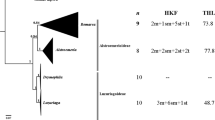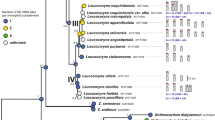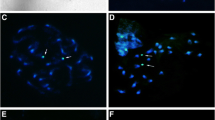Abstract
Mitotic chromosome numbers of 32 populations belonging to 23 species of the genus Lessingianthus H.Rob. (Vernonieae, Asteraceae) were determined. The chromosome number of all examined plants was found to be based on x = 16. The numbers observed varied from 2n = 32 to 2n = 176. The results include the first report of the chromosome number for 11 species: L. lanatus (2n = 32), L. varroniifolius (2n = 32), L. cataractarum (2n = 64), L. intermedius (2n = 64), L. argenteus (2n = 96), L. centauropsideus (2n = 96), L. profusus (2n = 96), Lessingianthus sp. nov. 1 (2n = 96), Lessingianthus sp. nov. 2 (2n = 128), L. robustus (2n = 160), and L. macrocephalus (2n = 176). New chromosome numbers were found in the four other species: L. rubricaulis, L. laniferus, and L. sellowii were tetraploid with 2n = 64, while L. oxyodontus was hexaploid with 2n = 96. B chromosomes were observed in L. coriaceus and L. varroniifolius. Lessingianthus macrocephalus (2n = 11x = 176) is reported as the first case of an odd polyploid and the higher chromosome number of Lessingianthus. The significance of the results is discussed in relation to chromosomal data available for the genus.


Similar content being viewed by others
References
Angulo MB and Dematteis M (2009a) Caryological analysis of South American species of Vernonia (Vernonieae, Asteraceae). Plant Biosystems. 143 (1):20–24
Angulo MB. and Dematteis M (2009b) Karyotype analysis in eight species of Vernonia (Vernonieae, Asteraceae) from South America. Caryologia 62 (2):81–88
Angulo MB, Dematteis M (2010) Pollen morphology of the South American genus Lessingianthus (Vernonieae, Asteraceae) and its taxonomic implications. Grana 49:12–25
Bhat V, Dwivedi KK, Khurana JP, Sopory SK (2005) Apomixis:aAn enigma with potential applications. Current Science 89 (11):1897–1893
Baker JG (1873) Compositae. I. Vernoniaceae. En: Martius, C. Fl bras 6(2):1–179
Bentham G (1873) Vernonieae. Genera Plantarum 2(1):227–231
Bretagnolle F, Thompson JD (1995) Gametes with the somatic chromosome number: mechanisms of their formation and role in the evolution of autopolyploid plants. New Phytol 129:1–22
Cabrera AL (1944) Vernonieas Argentinas (Compositae). Darwiniana 6(3):265–379
Camacho JPM, Sharbel TF, Beukeboom LW (2000) B chromosome evolution. Philos Trans R Soc Lond Ser B 355:163–178
Darlington CD (1965) Cytology. J. & A. Churchill, London
Dematteis M (1996) Estudios cromosómicos en especies argentinas de Vernonia (Asteraceae). Bonplandia 9(1–2):103–110
Dematteis M (1997) Números cromosómicos y cariotipos de algunas especies de Vernonia (Asteraceae). Bol Soc Argent Bot 33(1–2):85–90
Dematteis M (1998) Karyotype analysis in some Vernonia species (Asteraceae) from South America. Caryologia 51:279–288
Dematteis M (2000) Estudios cromosómicos en especies sudamericanas de Vernonia (Asteraceae). Doctoral thesis, Universidad Nacional de Córdoba, Argentina
Dematteis M (2002) Cytotaxonomic analysis of South American species of Vernonia (Vernonieae: Asteraceae). Bot J Linn Soc 139(4):401–408
Dematteis M (2004) Taxonomía del complejo Vernonia rubricaulis (Vernonieae, Asteraceae). Bonplandia 13(1–4):5–13
Dematteis M (2006) Two new species of Lessingianthus (Vernonieae, Asteraceae) from the Brazilian highlands. Bot J Linn Soc 150:487–493
Dematteis M (2009) Revisión taxonómica del género sudamericano Chrysolaena (Vernonieae, Asteraceae). Bol Soc Argent Bot 44(1–2):3–7
Dematteis M, Almeida GSS (2010) Lessingianthus. In: Forzza RC et al (eds) Catálogo de Plantas e Fungos do Brasil, vol 1, pp 715–718
Dematteis M, Fernández A (2000) Chromosome studies on nine South American species of Vernonia (Vernonieae, Asteraceae). Caryologia 53:55–61
Dematteis M, Molero J, Angulo MB, Rovira A (2007) Chromosome studies on some Asteraceae from South America. Bot J Linn Soc 153:221–230
Galiano NG, Hunziker JH (1987) Estudios cariológicos en Compositae. IV. Vernonieae y Eupatorieae. Darwiniana 28:1–8
Guerra M (1988) Introdução à Citogenética Geral, 6th edn. Guanabara koogan, Río de Janeiro
Harlan JR, De Wet JMJ (l975) On Ö. Winge and a prayer: the origins of polyploidy. Bot Rev 41:361–390
Hornsey KG (1973) The occurrence of hexaploid plants among autotetraploid populations of sugar beet (Beta vulgaris L.), and the production of tetraploid progeny using a diploid pollinator. Caryologia 26:225–228
Jackson RC, Newmark KP (1960) Effects of supernumerary chromosomes on production of pigment in Haplopappus gracilis. Science 132:1316–1317
Jamilena M, Riuz Rejon C, Ruiz Rejon M (1994) A molecular analysis of the origin of the Crepis capillaris B chromosome. J Cell Sci 107:703–708
Jones RN (1995) B-chromosomes in plants. New Phytol 131:411–434
Jones RN, Rees H (1982) The B-chromosomes. Academic, New York
Jones N, Houben A (2003) B chromosomes in plants: escapees from the A chromosome genome? Pl Sci 8:417–423
Jones SB (1979a) Synopsis and pollen morphology of Vernonia (Compositae: Vernonieae) in the New World. Rhodora 81:425–447
Jones SB (1979b) Chromosome numbers of Vernonieae (Compositae). Bull Torrey Bot Club 106:79–84
Jones SB (1981) Synoptic classification and pollen morphology of Vernonia (Compositae: Vernonieae) in the Old World. Rhodora 83:59–75
Keeley SC (1978) A revision of the West Indian Vernonias (Compositae). J Arnold Arbor 59:360–413
Keeley SC, Jones SB (1979) Distribution of the pollen types in Vernonia (Vernonieae: Asteraceae). Syst Bot 4:195–202
Keeley SC, Turner BL (1990) A preliminary cladistic analysis of the genus Vernonia (Vernonieae: Asteraceae). Pl Syst Evol Suppl 4:45–66
Keeley SC, Robinson H (2009) Vernonieae. In: Funk VA, Susanna A, Stuessy TF, Bayer RJ (eds) Systematics, evolution and biogeography of Compositae. International Association for Plant Taxonomy, Vienna, pp 439–469
Keeley S, Forsman ZH, Chan R (2007) A phylogeny of the “evil tribe” Vernonieae: Compositae) reveals Old/New World long distance dispersal: Support from separate and combined congruent datasets (trnLl, ndhF, ITS). Mol Phylogen Evol 44:89–103
Navashin M (1925) Polyploid mutations in Crepis.Triploid and pentaploid mutants of Crepis capillaris. Genetics 10:583–592
Oliveira VM, Forni-Martins ER, Semir J (2007a) Cytotaxonomic studies in six species of Vernonia (Asteraceae: Vernonieae). Caryologia 60:37–47
Oliveira VM, Forni-Martins ER, Semir J (2007b) Cytotaxonomy of species of Vernonia, section Lepidaploa, group Axilliflorae (Asteraceae, Vernonieae). Bot J Linn Soc 154:99–108
Otto SP, Whitton J (2000) Polyploid incidence and evolution. Annu Rev Genet 34:401–437
Quarin CL, Espinoza F, Martinez EJ, Pessino SC, Bovo O (2001) A rise of ploidy level induces the expression of apomixis in Paspalum notatum. Sex Plant Reprod 13:243–249
Ramsey J, Schemske DW (1998) Pathways, mechanisms and rates of polyploid formation in flowering plants. Ann Rev Ecol Syst 29:467–501
Ramsey J, Schemske DW (2002) Neopolyploid in flowering plants. Ann Rev Ecol Syst 33:589–639
Robinson H (1988a) Studies in the Lepidaploa complex (Vernonieae: Asteraceae). IV. The new genus Lessingianthus. Proc Biol Soc Wash 100:929–951
Robinson H (1988b) Studies in the Lepidaploa complex (Vernonieae: Asteraceae). V. The new genus Chrysolaena. Proc Biol Soc Wash 101:925–958
Robinson H (1999) Generic and subtribal classification of American Vernonieae. Smithsonian Contrib Bot 89:1–116
Robinson H (2007) Tribe Vernonieae. In: Kadereit J, Jeffrey C (eds) The families and genera of vascular plants, vol 8. Asterales,Springer, Berlin, pp. 165–192
Ruas PM, Ruas CF, Vieira AOS, Matzenbacher NI, Martins NS (1991) Cytogenetics of genus Vernonia Schreber (Compositae). Cytologia 56:239–247
Ruas PM, Ruas CF, Maffei EMD, Marin Morales MAM, Aguiar Perecin MLR (2000) Chromosome studies in the genus Mikania (Asteraceae). Gen Mol Biol 23:979–984
Salles-de-Melo MRC, Mendonça de Lucena R, Semir J, de Carvalho R, de Cássia Araújo Pereira R, Benko-Iseppon AM (2010) Karyological features and cytotaxonomy of the tribe Vernonieae (Asteraceae). Plant Syst Evol 285:189–199
Stace CA (1989) Plant taxonomy and biosystematics. Cambridge University Press, New York
Turner BL, Bacon J, Urbatsch L, Simpson B (1979) Chromosome numbers in south American Compositae. Am J Bot 66:173–178
Author information
Authors and Affiliations
Corresponding author
Rights and permissions
About this article
Cite this article
Angulo, M.B., Dematteis, M. Cytotaxonomy of some species of the South American genus Lessingianthus (Asteraceae, Vernonieae). Plant Syst Evol 298, 277–285 (2012). https://doi.org/10.1007/s00606-011-0542-z
Received:
Accepted:
Published:
Issue Date:
DOI: https://doi.org/10.1007/s00606-011-0542-z




